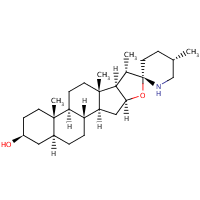|
immunological adjuvant
A substance that augments, stimulates, activates, potentiates, or modulates the immune response at either the cellular or humoral level. A classical agent (Freund's adjuvant, BCG, Corynebacterium parvum, et al.) contains bacterial antigens. It could also be endogenous (e.g., histamine, interferon, transfer factor, tuftsin, interleukin-1). Its mode of action is either non-specific, resulting in increased immune responsiveness to a wide variety of antigens, or antigen-specific, i.e., affecting a restricted type of immune response to a narrow group of antigens. The therapeutic efficacy is related to its antigen-specific immunoadjuvanticity.
phytotoxin
Any toxin produced by a plant.
antifungal agent
An antimicrobial agent that destroys fungi by suppressing their ability to grow or reproduce.
antimicrobial agent
A substance that kills or slows the growth of microorganisms, including bacteria, viruses, fungi and protozoans.
(via alkaloid antibiotic )
metabolite
Any intermediate or product resulting from metabolism. The term 'metabolite' subsumes the classes commonly known as primary and secondary metabolites.
(via alkaloid )
plant metabolite
Any eukaryotic metabolite produced during a metabolic reaction in plants, the kingdom that include flowering plants, conifers and other gymnosperms.
(via glycoalkaloid )
|
|
|
immunological adjuvant
A substance that augments, stimulates, activates, potentiates, or modulates the immune response at either the cellular or humoral level. A classical agent (Freund's adjuvant, BCG, Corynebacterium parvum, et al.) contains bacterial antigens. It could also be endogenous (e.g., histamine, interferon, transfer factor, tuftsin, interleukin-1). Its mode of action is either non-specific, resulting in increased immune responsiveness to a wide variety of antigens, or antigen-specific, i.e., affecting a restricted type of immune response to a narrow group of antigens. The therapeutic efficacy is related to its antigen-specific immunoadjuvanticity.
|
|
tomatine is a Structural Derivative of
|
tomatidine
Mass :
415.65174
Formula :
C27H45NO2

|
tetrasaccharide
Definition :
An oligosaccharide comprising four monomeric monosaccharide units.
|
oligosaccharide
Definition :
A compound in which monosaccharide units are joined by glycosidic linkages. The term is commonly used to refer to a defined structure as opposed to a polymer of unspecified length or a homologous mixture. When the linkages are of other types the compounds are regarded as oligosaccharide analogues.
|
carbohydrate
Definition :
Any member of the class of organooxygen compounds that is a polyhydroxy-aldehyde or -ketone or a lactol resulting from their intramolecular condensation (monosaccharides); substances derived from these by reduction of the carbonyl group (alditols), by oxidation of one or more hydroxy groups to afford the corresponding aldehydes, ketones, or carboxylic acids, or by replacement of one or more hydroxy group(s) by a hydrogen atom; and polymeric products arising by intermolecular acetal formation between two or more such molecules (disaccharides, polysaccharides and oligosaccharides). Carbohydrates contain only carbon, hydrogen and oxygen atoms; prior to any oxidation or reduction, most have the empirical formula Cm(H2O)n. Compounds obtained from carbohydrates by substitution, etc., are known as carbohydrate derivatives and may contain other elements. Cyclitols are generally not regarded as carbohydrates.
|
|
|





